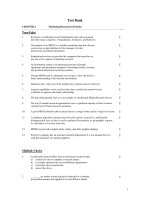Lecture Marketing research (12th edition) - Chapter 12: Designing the questionnaire
Bạn đang xem bản rút gọn của tài liệu. Xem và tải ngay bản đầy đủ của tài liệu tại đây (771.18 KB, 29 trang )
1
Marketing Research
Aaker, Kumar,
Leone and Day
Twelfth Edition
Instructor’s
2
Chapter Twelve
Designing the Questionnaire
Marketing Research 12th Edition
3
Designing the Questionnaire
Questionnaire building
is an art!
A questionnaire
is always custombuilt!
Marketing Research 12th Edition
4
The Process of Questionnaire Design
PLANNING WHAT TO MEASURE
Revisit the research objectives
Decide on the research issue of your questionnaire
Get additional information on the research issue from secondary data sources and exploratory
research
Decide on what is to be asked under the research issue
Decide how you want to analyze the data collected.
FORMATTING THE QUESTIONNAIRE
In each issue, determine the content of each question.
Decide on the format of each question
Marketing Research 12th Edition
5
The Process of Questionnaire Design (Contd.)
QUESTION WORDING
Determine how the question is worded
Evaluate each research question on the basis of comprehensibility, knowledge and ability,
willingness/inclination of a typical respondent to answer the question
SEQUENCING AND LAYOUT DECISIONS
Lay out the questions in a proper sequence
Group all the questions in each subtopic to get a single questionnaire
PRETESTING AND CORRECTING PROBLEMS
Read through the whole questionnaire to check whether it makes sense and it measures what
it is supposed to measure
Check the questionnaire for error
Pretest the questionnaire
Correct the problems
Marketing Research 12th Edition
6
Designing the Questionnaire
Marketing Research 12th Edition
7
Designing the Questionnaire (Contd.)
Formatting the Question
Decide on the degree of freedom
Alternatives
to be given to the respondents in
Open ended with no classification
Open ended where the interviewer uses precoded
answering the questions
•
•
classifications to record the response
•
Close ended or structured format in which a question
or a supplementary card presents the responses to
be considered
Marketing Research 12th Edition
8
OpenResponse Questions
•
•
•
•
•
For introduction to a survey or to a topic
When it is important to measure the salience of an issue to a
respondent
When there are too many responses to be listed, or they cannot be
foreseen
When verbatim responses are desired to give the flavor of people's
answers or to cite examples
When the behavior to be measured is sensitive or disapproved
How do you feel about the public transportation in downtown
Hartford?
------------------------------------------------------------------------------------------------------------------------------------------------------------------------------Marketing Research 12th Edition
9
Open Response Questions (Contd.)
Marketing Research 12th Edition
10
Closed Response Questions
Two Basic Formats for Closed Ended or
Structured Questions:
Marketing Research 12th Edition
11
Closed Response Questions (Contd.)
Marketing Research 12th Edition
12
Designing The Questionnaire (contd.)
Number of Response Categories
•
Generally five to seven categories
•
Ideally the multiple choices should be mutually exclusive
Order of Response Categories :
•
Can affect responses
•
What factor influences your fastfood restaurant choice most ?
Convenient location Quality of food
Menu selection Fast service
Reasonable prices
•
Brand name
Cleanliness
To prevent order bias, place the average or expected response at
various positions in the sequence of categories
Marketing Research 12th Edition
13
Range of Response Categories
•
Respondents who do not know the answer
might take categories as cues.
How many longdistance calls do you make in a week?
less than 5
510
or
More than 10.
less than 10
1020
More than 20.
Marketing Research 12th Edition
14
Handling Uncertainty and Ignorance
Concerns the handling of “don’t know” and
neutral responses
▫
May be advisable to provide the interviewer with an additional
“no answer” category to identify these people correctly
Marketing Research 12th Edition
15
Using Both OpenResponse & ClosedResponse
Questions
Probe:
Using an openresponse question to follow up a closed
response question
Two general purposes for the use of probes:
•
•
Pinpoint questions that were particularly difficult for
respondents
Aid researcher interpretation of respondent answers
Marketing Research 12th Edition
16
Question Wording
Marketing Research 12th Edition
17
Question Wording (contd.)
•
Avoid ambiguous words
How many times per month do you visit a fastfood restaurant?
•
Never
Occasionally
Sometimes
Often
Check if any of the questions are loaded
1.
2.
Don’t you think, because it’s so greasy, fastfood is one of the worst types of food?
Do you prefer a hamburger that is grilled on a hot stainlesssteel grill or cooked by
passing the raw meat through an open gas flame?
Marketing Research 12th Edition
18
Question Wording (contd.)
•
Are any questions "doublebarreled”?
Are you satisfied with the price and the service of Taco Bell?
•
Is the question applicable to all respondents?
Why do you like fastfood?
Assumes that respondent likes fastfood!
Marketing Research 12th Edition
19
Asking Sensitive Questions
Example: Consumption of Kellogg’s Frosted Flakes
•
The casual approach
“Have you eaten ‘Frosted Flakes’ within the last week?
•
The numbered card
“Would you please read off the number on this card that
corresponds to what you had eaten for breakfast in the last week?”
(Hand card to respondent)
1.
Pancakes
2.
Frosted Flakes
3.
Other (what)?
Marketing Research 12th Edition
20
Asking Sensitive Questions (Cont.)
•
The everybody approach
“As you know, many people have been eating Frosted Flakes for breakfast.
Do you eat Frosted Flakes?”
•
The “other people” approach
“Do you know of any adult who eats Frosted Flakes?”
“How about yourself?”
Marketing Research 12th Edition
21
Asking Sensitive Questions (Contd.)
The sealed ballot technique
Explain that the survey respects people’s right to anonymity with
respect to their eating habits
and
Respondents themselves are to fill out the answer to the question,
seal it in an envelope, and drop it in a box conspicuously labeled
“sealed ballet box” carried by the interviewer
The Kinsey approach
Look into respondent’s eyes and ask in simple clearcut language
“Do you eat Frosted Flakes for breakfast?”
Marketing Research 12th Edition
22
Asking Sensitive Questions (Contd.)
•
Randomized Response Technique
▫
•
The respondent is asked to answer one or two randomly selected
questions without revealing which question has been answered
Questions:
Sensitive
▫ Innocuous
▫
Since the interviewer records a “yes” or “no” answer without knowing which
question has been answered, the respondent feels free to answer honestly
Marketing Research 12th Edition
23
Randomized Response Technique
P[Yes] = P[Yes|S.Q] * P[S.Q] + P[Yes|I.Q] *
P[I.Q]
where
S.Q = Sensitive Question
I.Q = Innocent Question
Marketing Research 12th Edition
24
Sequence And Layout Decisions
•
•
•
•
•
•
Open with an easy and nonthreatening question
Ensure that questionnaire has smooth and logical flow
from one topic to the next
Proceed from broad general questions to more specific
ones
Do not place sensitive or difficult questions dealing with
income status, ability etc at the beginning of the
questionnaire
Use good quality of paper
Make physical layout appealing and interesting
Marketing Research 12th Edition
Organization of a Typical Questionnaire
25
Marketing Research 12th Edition









